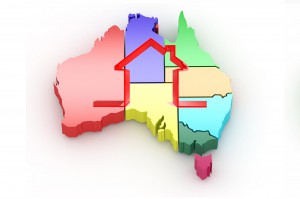Building activity data for the June 2017 quarter was published by the Australian Bureau of Statistics earlier this week.
The data contains additional insight to the housing construction sector, tracking quarterly dwelling commencements, completions and counts of dwellings under construction.
The data is showing a softening in commencements as approvals have slowed but still heightened levels of completions and dwellings under construction.
Dwelling commencements
Over the June 2017 quarter, seasonally adjusted data showed that 28,087 new houses and 24,380 new units commenced construction nationally. 
The number of houses commenced was 3.3% higher over the quarter but -7.1% lower than a year earlier while unit commencements were down -0.8% over the quarter and -6.6% lower over the year.
Year-on-year new house commencements were lower in each state and territory, recorded at: -3.5% in NSW, -7.2% in Vic, -3.1% in Qld, -10.6% in SA, -12.2% in WA, -7.0% in Tas, -29.1% in NT and -37.9% in ACT.
Year-on-year new unit commencements were higher in NSW (3.3%), Vic (3.2%), SA (35.0%) and Tas (153.1%) and they were lower in Qld (-30.4%), WA (-40.5%), NT (-40.9%) and ACT (-17.7%).
Commencements for houses picked up over the quarter but are lower across all regions over the year.
Meanwhile unit commencements are trending lower in most states and territories with notable exception of NSW, Vic and Tas.
NSW and Vic have been home to the two strongest housing markets over recent years (Sydney and Melbourne) and are seeing the largest increases in population fuelling housing demand.
Meanwhile, dwelling values in Tasmania’s largest city (Hobart) are rising at the fastest rate of any capital city while stock levels are very low so it seems a supply response is occurring.
Dwelling completions
Seasonally adjusted data nationally shows that over the June quarter there were 28,251 houses and 25,090 units completed nationally.
Interestingly these figures are fairly closely aligned to commencements so what was completed was effectively replaced as having started construction.
Over the quarter, new house completions were down -1.2% and new unit completions were -10.2% lower.
Year-on-year new house completions were -9.0% lower and new unit completions were down -5.2%.
State and territory data which isn’t seasonally adjusted shows that year-on-year, new house completions rose in NSW (8.6%), Qld (18.3%) and ACT (73.3%) while completions were lower in Vic (-12.8%), SA (-3.7%), WA (-45.3%), Tas (-29.8%) and NT (-44.2%).
New unit completions increased over the year in Vic (11.1%), Qld (13.7%) and ACT (29.6%) and were lower in NSW (-20.4%), SA (-41.6%), WA (-22.3%), Tas (-40.0%) and NT (-69.9%)
Completions remain at high levels however, they have eased back a little.
Given that there remains a high volume of stock under construction (as we will analyse shortly) it’s anticipated that completions are likely to remain elevated for some time.
Dwellings under construction
At the end of the June 2017 quarter, there were 216,242 dwellings under construction nationally. 
Although the number of dwellings under construction is down from its historic high of 224,314 in September 2016, it is still at an extremely elevated level.
As a comparison, the long-term average number of dwellings under construction at the end of a quarter is 106,774 and even over the past 10 years the average has been recorded at 153,545.
In June 2017, there were 62,409 new houses and 151,510 new units under construction nationally.
Again, both are well above the long-run averages of 48,329 and 38,964 respectively.
Looking at the data across the states, at the end of the quarter the number of new houses under construction was recorded at: 17,845 in NSW, 21,401 in Vic, 8,605 in Qld, 4,726 in SA, 7,669 in WA, 1,227 in Tas, 276 in NT and 660 in ACT.
By comparison, the long-term average number of houses under construction across the states is recorded at: 13,566 in NSW, 15,186 in Vic, 7,250 in Qld, 3,681 in SA, 7,455 in WA, 1,548 in Tas, 544 in NT and 938 in ACT.
All states and territories except for Tas, NT and ACT currently have more new houses under construction than the long-term average.
The number of new units under construction is where there is generally a substantial deviation from the long-term average.
Across the states, at the end of the June 2017 quarter the number of new units under construction was recorded at: 64,470 in NSW, 43,240 in Vic, 27,420 in Qld, 4,230 in SA, 6,360 in WA, 391 in Tas, 495 in NT and 4,904 in ACT. 
Tas is the only state or territory with fewer new units currently under construction than its long-term average which is recorded at 431.
Across the remaining states, the long term average number of new units under construction is: 17,162 in NSW, 10,854 in Vic, 7,897 in Qld, 1,955 in SA, 3,382 in WA, 445 in NT and 1,235 in ACT.
The current number of new units under construction in NSW (+276%), Vic (+298%), Qld (+247%), SA (+116%) and ACT (+297%) is well in excess of double the long-term average.
The volume of new housing stock under construction remains at dizzying heights, albeit not quite as high as a few quarters ago.
The surge in stock under construction is being driven by units which by nature take longer to build and deliver more stock in a single project than houses.
Interestingly, the number of units under construction has slowed in Vic and Qld but continues to climb in NSW.
This is probably to do with the fact that many property purchasers in NSW can simply no longer afford houses (particularly in Sydney) so units become their only housing purchase option.
Conclusion
Although dwelling approvals have eased from their record high levels, over recent months they have been fairly steady. 
They seem to have settled at a level which is well above long-term average levels.
While this means that commencements won’t be as strong going forward they are likely to remain high relative to historic levels.
There is a significant number of new dwellings (particularly units) under construction which means that completions are likely to remain elevated for some time.
Once they do fall we would expect them to stabilise at a level well above the long-term average.
With the national population increasing rapidly, these people need to be housed so although housing construction is unlikely to remain as strong as it has been recently, we do expect that a substantial volume of housing construction is likely to continue to take place.
from Property UpdateProperty Update https://propertyupdate.com.au/pipeline-of-housing-stock-has-peaked-but-pending-supply-remains-well-above-long-term-average-levels/

No comments:
Post a Comment